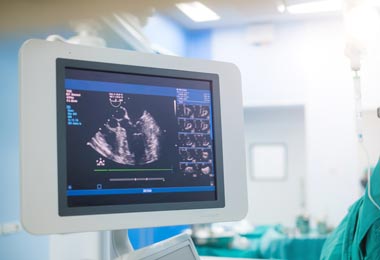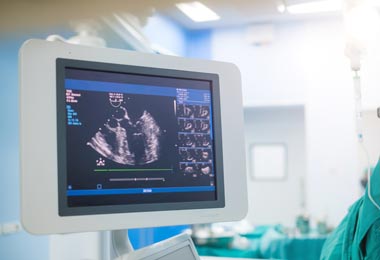Cardiac Resynchronization Therapy
What is cardiac resynchronization therapy?
Cardiac resynchronization therapy (CRT) is treatment to help restore the normal rhythm (timing pattern) of the heartbeat.
A dual chamber pacemaker can help coordinate the timing of the upper heart chambers (atria) and the lower heart chambers (ventricles). A CRT pacemaker is a specific type of pacemaker with an additional wire that goes to the left side of the heart. This allows it to coordinate the timing between the left and right sides of the heart.
When your heart doesn’t pump strongly enough, fluid can build up in your lungs and your legs. This is called heart failure. In some people, this condition can happen when the two bottom chambers (ventricles) of your heart don’t beat at the same time. An example of this is a condition called a left bundle branch block. For this, there is a delay along the electrical pathway in the left ventricle.
CRT pacemakers can also be combined with an implantable cardioverter defibrillator. Your healthcare provider may advise this if they determine that you also need an implantable cardioverter defibrillator (ICD). This device fixes the timing of the heartbeat and treats dangerous fast heart rhythms.
CRT therapy means you will need to have the pacemaker placed under your skin by minor surgery. Wires from the device are connected to the ventricles on both sides of your heart. The CRT device sends electrical signals to the ventricles to make them pump together the way they should. This type of electrical stimulation is called biventricular pacing.
CRT therapy works in about 7 out of 10 people who have heart failure and mismatching (dyssynchrony) of their heartbeat. Not everyone with heart failure can be helped by CRT. For instance, if you have very advanced heart failure, you are not as likely to respond to CRT. CRT also works best for people who have a condition called left bundle branch block. Overall, CRT may improve your survival, heart function, and quality of life if you have heart failure and left bundle branch block. It may also improve your ability to exercise.
Why might I need cardiac resynchronization therapy?
Your healthcare provider may suggest CRT if:
-
You have moderate to severe heart failure symptoms.
-
The pumping chambers (ventricles) of your heart are not working together and you are found to have a left bundle branch block
-
Tests show that your heart is weak and enlarged.
-
Medicines and lifestyle changes are not working well enough to control your heart failure
-
You have complete heart block and will need pacing from the right ventricle most of the time.
What are the risks of cardiac resynchronization therapy?
CRT is not considered a major or dangerous type of procedure. But like all surgery, it carries some risks. They include:
-
Reaction to the anesthesia
-
Swelling or bruising in your upper chest area where the CRT device is placed
-
Bleeding, including bleeding from the heart
-
Infection
-
Heart rhythm problems
-
Movement of the device or the device wires that may need a second surgery
-
Mechanical problems with the CRT device
-
Worsening of kidney function
-
Collapsed lung (pneumothorax)
-
Frequent hiccup sensation or twitch from the wire on the left side activating the nerve to your diaphragm. This is called diaphragm stimulation. It can typically be fixed with programming changes to your device.
There may be other risks, depending on your specific health condition. Be sure to discuss any concerns with your healthcare provider before the procedure.
How do I get ready for the insertion of a CRT device?
Let your healthcare provider know about any:
-
Prescription medicines that you take
-
Over-the-counter medicines or supplements you take, especially aspirin
-
Allergies
-
Recent symptoms of colds or infections
-
History of problems with anesthesia
You should discuss all the risks and benefits of the procedure with your healthcare provider. Follow any directions you are given for not eating or drinking before surgery. If you usually take medicines in the morning, ask your healthcare provider if you can take them with a sip of water.
Your healthcare team may ask you to stop taking any medicines that thin your blood several days before the procedure. If you take certain medicines for diabetes, ask your healthcare provider how to adjust your dose around your surgery.
What happens during insertion of a CRT device?
Your healthcare provider may insert your CRT device on an outpatient basis, or as part of your stay in a hospital. Procedures may vary, depending on your condition and your healthcare provider's practices. Talk with your healthcare provider about what will happen during your procedure.
The actual procedure may take from 2 to 3 hours. You’ll probably be awake but relaxed and sleepy during the procedure. This is what you can expect:
-
In the procedure room, you will lie down on an X-ray table.
-
An IV (intravenous) line will be put into your hand or arm. Your healthcare team will give you fluids, antibiotics, and pain medicine through this line.
-
Your team will watch your heart, blood pressure, and oxygen level.
-
Your healthcare provider will give you medicines to help you relax or fall asleep. They will also numb the area where the device will be placed. This is usually just under your left collarbone (clavicle).
-
Your healthcare provider will make a small cut (incision) and create a pocket under the skin. This pocket will hold the wires and computer battery pack (generator) for the CRT.
-
Your healthcare provider will put IV lines in the large vein that feeds into your heart. Then the healthcare provider will put CRT wires (leads) into the vein and feed them into your heart. Special X-rays will be taken to make sure the leads are in the right place on both sides of your heart. Unlike the wires that travel to the right side of the heart, the wire going to the left side will be attached inside a vein that goes around the back left side of the heart.
-
Your healthcare provider will test the leads with an electric pulse. It may feel as if your heart is racing.
-
If the leads are in the right place and working as they should, they will be attached to the CRT pacemaker. Your healthcare provider will put the pacemaker through the incision and under your skin.
-
The incision will be closed with stitches or staples and a dressing will be put on.
What happens after the CRT device is inserted?
You will be moved to the recovery area. You will stay there until the relaxing medicine has worn off. A healthcare provider will give you pain medicines as needed. You will have a chest X-ray. You may need to stay in the hospital overnight while your healthcare provider checks and adjusts the settings on your CRT device.
After you leave the hospital, it will be important to follow all of your healthcare provider's advice and keep all follow-up appointments.
Here’s what you can expect once you’re home:
-
You should be able to follow your normal diet.
-
You will need to limit activities, such as lifting, straining, and stretching that use the affected arm (usually left) for the first 4 to 6 weeks. Ask your healthcare provider when you can return to these activities.
-
Keep the dressing clean and dry until your healthcare provider tells you it is OK to remove the dressing and take a shower.
-
Check your incision area for any signs of infection. Let your healthcare provider know if you have any fever, redness, soreness, discharge, bleeding, or swelling.
Here are the likely long-term instructions for living with your CRT device:
-
Make sure to have your healthcare provider check the functioning of your device regularly. This should be done at least once every 6 months. Most devices can be watched remotely with a home communicator.
-
Carry a CRT pacemaker identification card and let all your caregivers know about your device.
-
Your pacemaker battery will last for about 10 years. Your healthcare provider will be able to tell about 6 months before the battery runs down. Replacing the CRT pacemaker is a minor procedure.
-
If advised, stay away from devices that have strong magnetic fields. These include electrical generators and industrial electric welders. In general, household appliances such as microwave ovens are safe. Talk with your healthcare provider if you have any questions about what to stay away from.
-
Most X-rays and metal detectors are safe, but you should stay away from metal wands used for airport screenings. Most modern day devices are MRI compatible.
-
Be careful when using cell phones and other electronic devices. Keep them at least 6 inches away from your CRT device. It's safest to hold all cell phones to the ear farther from your CRT device or use the speaker mode setting. Don’t carry your phone or electronic device in your chest pocket, over the CRT device. Experts advise carrying your cell phone and other electronics in a pocket or bag below your waist. Most cell phones and electronic devices don't interfere with CRT devices. But some cell phones and electronic devices, such as smart watches, use powerful magnets for wireless charging. These may interfere with the normal function of your CRT device. The magnet used for charging or other magnet accessories can also interfere with the normal function of your CRT device These devices should be kept away from your CRT device when wirelessly charging and stored. Follow any other instructions given to you by your healthcare provider or from the manufacturer of your CRT device.
Next steps
Before you agree to the test or procedure make sure you know:
-
The name of the test or procedure
-
The reason you are having the test or procedure
-
What results to expect and what they mean
-
The risks and benefits of the test or procedure
-
What the possible side effects or complications are
-
When and where you are to have the test or procedure
-
Who will do the test or procedure and what that person’s qualifications are
-
What would happen if you did not have the test or procedure
-
Any alternative tests or procedures to think about
-
When and how you will get the results
-
Who to call after the test or procedure if you have questions or problems
-
How much you will have to pay for the test or procedure





